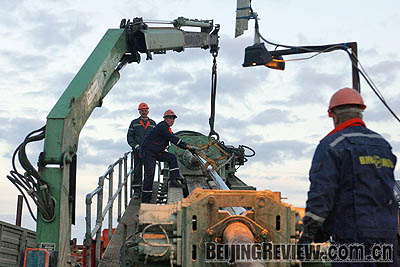|

ENERGY GIANT: A file photo of workers constructing a gas pipeline in Ivanovo, Russia. Russia's rich oil and gas resources are of great interest to its Northeast Asian neighbors
As Northeast Asia rapidly rises to become one of the most dynamic economies in the world, its energy demands are skyrocketing. China, Japan and South Korea are all big energy consumers with deepening dependence on energy imports. Regional energy security and prospects for cooperation topped the agenda of the Fourth China Jilin Northeast Asia Investment and Trade Expo in Changchun, Jilin Province, in early September. Against a backdrop of worsening energy shortages and soaring oil prices, experts believe that countries in Northeast Asia should go beyond bilateral cooperation with Russia to explore a broader multilateral cooperative system to overcome their ongoing energy crunches.
Complementary structure
Oil resources are distributed unevenly in Northeast Asia. Russia is the world's biggest natural gas producer and second biggest oil producer. It produced 490 million tons of oil and 546 million tons of natural gas in oil equivalent, accounting for 12.6 percent and 20.6 percent, respectively, of the world total. Other countries in the region, however, are all oil importers.
Experts predict that given the changes in Russia's oil export strategy, exports to Asia-Pacific countries will account for 30 percent of all its oil and gas exports by 2020, a notable rise from today's 3 percent. There is a huge potential demand for high quality, clean and efficient natural gas in Northeast Asia. It will join Europe and North America to become the world's three major international gas markets. By 2020, the region's annual gas demand is projected to exceed 60 billion cubic meters.
Russia's strong production capacity is highly complementary to the huge oil and gas consumption in China, Japan and South Korea, said Cui Minxuan, a research fellow at the Chinese Academy of Social Sciences, at this year's Northeast Asia Investment and Trade Expo. Russia regards Northeast Asia as a major partner in oil and gas cooperation, while countries in Northeast Asia expect Russia to provide stable oil and gas supplies for the region, he said. Their mutual needs pave the way for regional energy cooperation in Northeast Asia, he added.
Russia is bound to establish a regional cooperative system with Northeast Asian countries, said Zhu Xianping, Vice Dean of the Northeast Asian Studies Academy at Jilin University. He believes their cooperation will bring about win-win results, with China, Japan and South Korea securing less expensive oil and gas supplies and Russia gaining a stable export market and obtaining a large amount of investment to develop its oil and gas resources and build infrastructure.
Multilateral arrangement
Oil importers in Northeast Asia have committed to diversifying their imports in recent years. With their eyes set on the rich oil and gas resources in Russia's Siberia and Far East, they vie to court the country.
Nevertheless, energy cooperation in the region is still in the primary stage, with Northeast Asian countries' bilateral cooperation with Russia being the norm. The craze for bilateral cooperation risks leading to vicious competition over energy resources. Recent years have seen Northeast Asian countries pour investment into oil and gas development on the Sakhalin Island shelf. Their cutthroat competition is detrimental to the countries' relations and the region's prosperity and stability.
Due to the absence of an integrated system for energy cooperation, Northeast Asian countries have yet to resolve the energy bottlenecks hindering their development. The "Asian premium" is a telling example of Northeast Asia's energy dilemma. Without a mechanism to protect their common interests, China, Japan and South Korea find themselves at a disadvantage in international oil pricing. As a result, Asian oil consumers pay oil producers $5 billion to $10 billion more than they are due every year. The three major oil importers in the region are heavily burdened by the Asian premium. The lack of an oil reserve mechanism, in particular, has made China a major victim.
| 